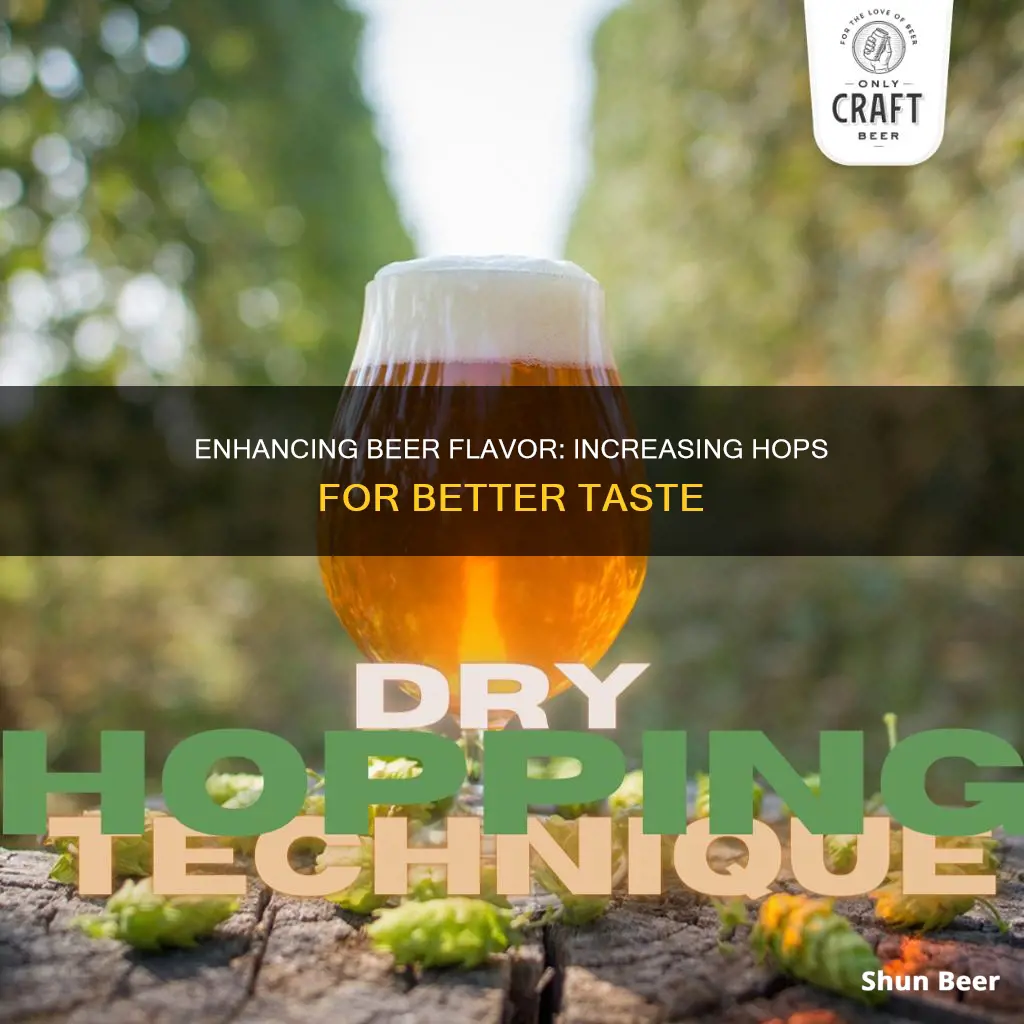
Hops are an essential ingredient in beer, providing bitterness, flavour, and stability. The hops plant, a member of the Cannabaceae family, has separate male and female plants, with only the female plants being used for commercial production. The flowers, also known as seed cones or strobiles, are used to impart unique flavours and aromas to beer. The resins and oils inside the lupulin glands of the hop cones are responsible for the distinct characteristics that hops contribute to beer.
To increase the hops in beer, several techniques can be employed during the brewing process. The timing of hop additions plays a crucial role in extracting different qualities from the hops. The longer the hops are exposed to heat, the more bitter the beer becomes, while shorter additions or post-boil additions preserve the delicate hop oils that contribute to flavour and aroma.
One technique is to utilise first wort hopping (FWH), where hops are added to the kettle before the sparge begins, resulting in a smoother bitterness and a harmonious blend with flavour and aroma hops. Another method is continuous hopping, where hops are added from the start of the boil to flame-out, creating a smoother blend of hops characteristics. Hops bursting is a variation of the standard three-addition hopping schedule, emphasising late-addition hops for a lighter bitterness and more pronounced aromatics.
Additionally, dry hopping, or fermenting beer with hops, is a common practice to enhance aroma without adding extra bitterness. Wet hopping, using fresh, undried hops within 24 hours of harvesting, also imparts vivid aroma and flavour profiles.
| Characteristics | Values |
|---|---|
| Hop type | Bittering, flavouring, aroma, dual-use |
| Hop form | Whole flower/cone, pellet, powder, extract, "hash" |
| Hop origin | American Hallertau, German Hallertau, Spalt, Tettnang, Žatec (Saaz) |
| Hop timing | First wort, mash, boil, post-boil, post-packaging, dry |
| Hop quantity | 0.125–0.7 oz per addition, 0.5 oz per gallon for dry hopping |
What You'll Learn

The role of hops in the brewing and fermentation process
Hops are the flowers (also called seed cones or strobiles) of the hop plant Humulus lupulus, a member of the Cannabaceae family of flowering plants. They are used as a bittering, flavouring, and stability agent in beer, adding bitterness, floral, fruity, or citrus flavours and aromas. Hops also have antibacterial effects, which help to keep beer fresh for longer.
Hops are divided into two very general categories: bittering and aroma. Bittering hops have higher levels of alpha acids, which are responsible for the bitter flavour of a beer. Aroma hops tend to have more essential oils, which are highly volatile and contribute to the "hoppiness" of a beer.
The timing of when hops are added during the brewing and fermentation process will affect the flavour of the beer. Hops added early in the brewing process will have their essential oils volatilize during the boil or fermentation, which is why adding them later in the process tends to make a beer smell "hoppier". Hops added during the boil are considered "bittering hops", while those added later, during the final 10 minutes or less, are considered "aroma hops".
There are also different techniques for adding hops during the brewing process, such as dry hopping (adding hops during fermentation) and wet hopping (brewing with fresh, undried hops within 24 hours of being harvested). These techniques allow brewers to experiment and create beers with different flavour and aroma profiles.
Overall, the role of hops in the brewing and fermentation process is crucial in determining the flavour, aroma, and stability of the final beer product.
Hops and Hormones: The Estrogen-Beer Link Explained
You may want to see also

The different types of hops
Hops are the flowers of the hop plant, Humulus lupulus, and are used as a bittering, flavouring, and stabilising agent in beer. They are also used in herbal teas and soft drinks. There are two main types of hops: bittering and aroma.
Bittering hops
Bittering hops have higher concentrations of alpha acids and are responsible for the bitter flavour in beer. They are boiled for a longer period of time, typically 60-90 minutes, which often results in inferior aromatic properties as the aromatic compounds evaporate. European hops typically average 5-9% alpha acids by weight, while American cultivars range from 8-19%.
Aroma hops
Aroma hops usually have a lower concentration of alpha acids (around 5%) and are the primary contributors of hop aroma and flavour. They are typically added to the wort later in the process to prevent the evaporation of essential oils. Aroma hops are often added after the wort has cooled and while the beer ferments, in a technique known as "dry hopping".
Dual-use hops
In addition to the two main types, there are also dual-use hops, which have high concentrations of alpha acids and good aromatic properties. These hops can be added to the boil at any time, depending on the desired effect.
Smirnoff Flavored Beer: Hops or No Hops?
You may want to see also

The timing of adding hops during the brewing process
Hops are typically added to the wort during three stages of the boil: bittering, flavouring, and aroma. However, the number of hop additions can vary from one to up to six, depending on the desired complexity of the beer.
Bittering hops are added once the wort has been collected in the kettle and a rolling boil has been achieved. They are usually boiled for 60 minutes but can be boiled for as little as 30 minutes. All beers include bittering hops to balance the sweetness of the malt and to act as a natural preservative. The longer the hops are boiled, the more bitter the beer becomes, which is identified as a higher IBU (International Bitterness Unit).
Flavouring hops are added with 15 to 30 minutes remaining in the boil. During this timeframe, minimal bitterness is extracted, but the crisp hoppy flavour is imparted.
Aroma hops are added during the last 5 minutes of the boil or at flame-out (when the kettle is removed from the heat). The hop oils responsible for aroma are extremely volatile and will be driven off by steam, so aroma hops must not be boiled for long to produce the maximum amount of aroma.
In addition to the standard three-addition hopping schedule, there are other techniques for adding hops at different stages of the brewing process. These include:
- First Wort Hops (FWH): Hops are added to the kettle before the sparge begins, allowing them to soak in the collected wort before the boil. This technique yields about 10% more IBUs than a 60-minute boil and is said to produce a smoother bitterness.
- Continuous hopping: Hops are added from the start of the boil to flame-out, creating a smoother blend of hops characteristics.
- Hops bursting: A variation of the standard three-addition hopping schedule, where most or all of the bitterness comes from the final hops contribution, resulting in increased hops flavour and aroma.
- Hops stand or whirlpool hopping: Hops are added post-boil, either at flame-out or after chilling the wort slightly, and allowed to stand for 10-45 minutes before chilling. This technique intensifies both the flavour and aroma of the hops.
- Dry hopping: Hops are added to the fermentor or keg after primary fermentation is complete, adding aroma without increasing bitterness.
- Wet hopping: Using fresh, un-dried hops within 24 hours of being harvested, resulting in vivid aroma and flavour profiles with decreased bitterness.
- Mash hopping: A controversial technique where hops are added to the mash, said to contribute a more interesting flavour and aroma, but most brewers find this effect faint.
The timing of hop additions depends on the desired flavour, bitterness, and aroma profile of the beer. By varying the timing and techniques of hop additions, brewers can create complex and unique beers that showcase the diverse characteristics of hops.
The Evolution of Tropical Hops in Beer
You may want to see also

The impact of hops on the flavour and aroma of beer
Hops are an essential ingredient in brewing beer, and they play a crucial role in determining its flavour, aroma, and overall quality. They are the flowers of the hop plant (*Humulus lupulus*), which originated in central Europe. Hops have been used in brewing for centuries, originally for their preservative and antibacterial properties, and today, they are primarily used for flavour and aroma.
Hops contribute bitterness, flavour, and aroma to beer. The longer the hops are boiled in the brewing process, the more bitter they become. This bitterness can help balance the sweetness of the malted barley used in beer, creating a more complex and satisfying taste. Different varieties of hops have different flavour profiles, ranging from floral, citrus, herbal, and spicy notes to fruity, piney, and earthy notes. These flavours can be combined to create a unique taste for each type of beer.
The essential oils in hops are responsible for their aroma, giving off a variety of fragrances, including fruity, floral, herbal, piney, and earthy scents. The aroma of hops is vital to the beer-drinking experience, as it is one of the first things one notices when taking a sip.
To increase the impact of hops on the flavour and aroma of beer, brewers can adjust the timing and techniques of hop additions during the brewing process. Hops can be added at different stages, such as the bittering addition, aroma addition, or dry hopping, to achieve different effects. The longer the hops are boiled, the more bitter the beer will become, and the higher the International Bitterness Unit (IBU) rating will be. However, boiling hops for too long can drive off the volatile oils that contribute to the aroma and flavour of the beer. Therefore, brewers often add hops towards the end of the boil or during the whirlpool stage to preserve their delicate flavours and aromas.
Additionally, the type and form of hops used can impact their flavour and aroma contribution. Different varieties of hops have unique flavour and aroma profiles, and brewers can select hops with higher proportions of specific elements they want to emphasise in their beer. The form of hops, such as whole flower/cone, pellet, powder, or extract, can also affect the surface area exposed to the brewing process, influencing the extraction of oils and resins/acids.
In summary, the impact of hops on the flavour and aroma of beer is significant. By understanding the characteristics of different hop varieties and the effects of various brewing techniques, brewers can create beers with complex and interesting flavour and aroma profiles.
Hops: Brewing Demand and Future Growth
You may want to see also

Techniques for increasing hops in beer
Hops are added to beer to provide bitterness, flavour, and aroma. The longer hops are exposed to heat, the more bitter the beer will become, and the less flavour it will have. Thus, the timing of when hops are added is crucial.
First Wort Hopping (FWH)
First wort hopping involves adding hops to the kettle as the wort is draining from the mash into the kettle. This technique is a "pre-boil" hopping or an extra-long 60-minute hop addition. Hops added at this stage impart bitterness to the beer, with the longer the hops are in the boil, the more bitter it becomes.
Minute Additions (60, 30, 15, 10, 5)
These are the most common times to add hops to a beer. Hops are added directly to the wort or inside a hop spider, which is a stainless steel mesh sleeve that prevents boil hops from getting into the fermenter and limits water loss. Minute additions mostly impart bitterness to the beer, and thus hops with higher alpha acids are used to create more bitterness.
Flame Out
Hops added at flame out are added to the wort or hop spider as soon as the kettle is removed from the heat source. The changing of wort temperature will extract different flavours and oils from the hops, adding complexity to the beer. Hops added at this stage impart some bitterness and aroma to the beer.
Whirlpool
Hops are added at a specific temperature, which is then held for a specific period. The whirlpool is created by swirling the wort with a pump and recirculation hose. Hops added above 175 °F (79 °C) will impart more bitterness, while hops added below that temperature will add more aroma.
Hop Bursting
Hop bursting is adding all hops at the end of the boil or very late. This technique can be part of "Late Additions", "Flameout", "Whirlpool", or "Hop Stand".
Dry Hopping
Dry hopping is a common practice where hops are added post-chill, typically during primary fermentation. This technique adds hops oils and some bitterness to the beer without contributing any measurable IBUs as there is no heat involved.
Continuous Hopping
Continuous hopping involves adding hops from the start of the boil to flame-out, creating a smoother blend of hops characteristics. This technique was pioneered by Sam Calagione of Dogfish Head Craft Brewed Ales for his 90 Minute IPA.
Hopback
A hopback is a container with an inlet and outlet that is packed with leaf hops. Hot wort is pumped through the hopback and into the chiller, infusing the wort with the essential oils of the hops. This technique is intended to accentuate the hops' aroma.
Randall
The Randall, or Randall the Enamel Animal, is a device similar to a hopback but designed for serving beer. Hops are placed in its chamber, and the Randall is attached to a beer dispensing system, filtering the beer through the hops.
Exploring Mexican-Style Beer: A Hoppy Adventure
You may want to see also
Frequently asked questions
Hops are used to balance the sweetness of the malt with bitterness and a variety of flavours and aromas. They also have an antibacterial effect over less desirable microorganisms.
Hops should be added early in the brewing process and boiled for a longer period of time, typically 60–90 minutes, to increase bitterness. The longer the hops are boiled, the more bitter the beer will become.
Hops should be added with between 15 and 30 minutes remaining in the boil to increase flavour. In this time frame, very little bitterness will be extracted from the hops, but a crisp hoppy flavour will be imparted.
Aroma hops must not be boiled for long as the oils that are responsible for the aroma are extremely volatile and will be driven off in the steam. Aroma hops are typically added during the last 5 minutes of the boil or at flame out.







